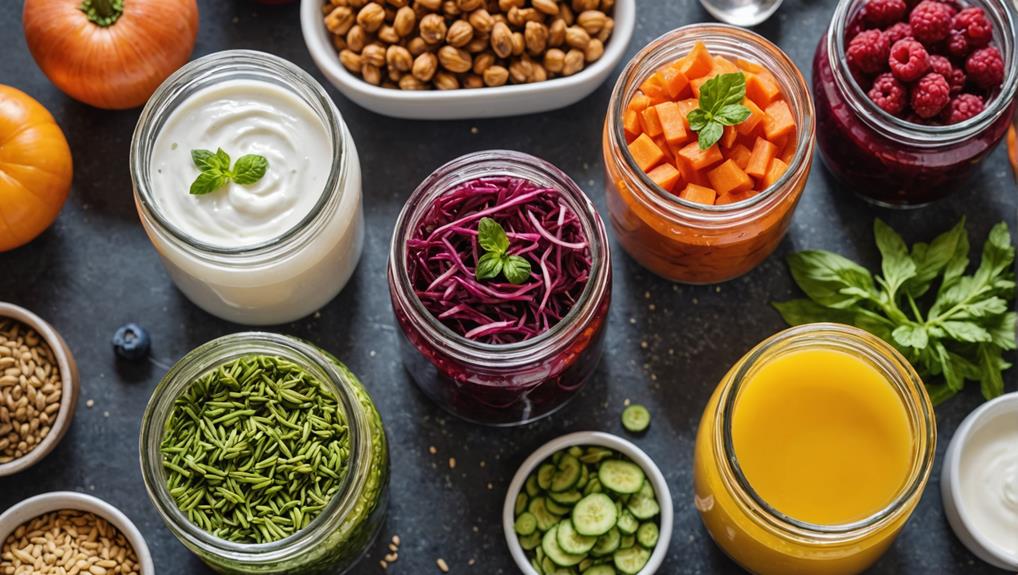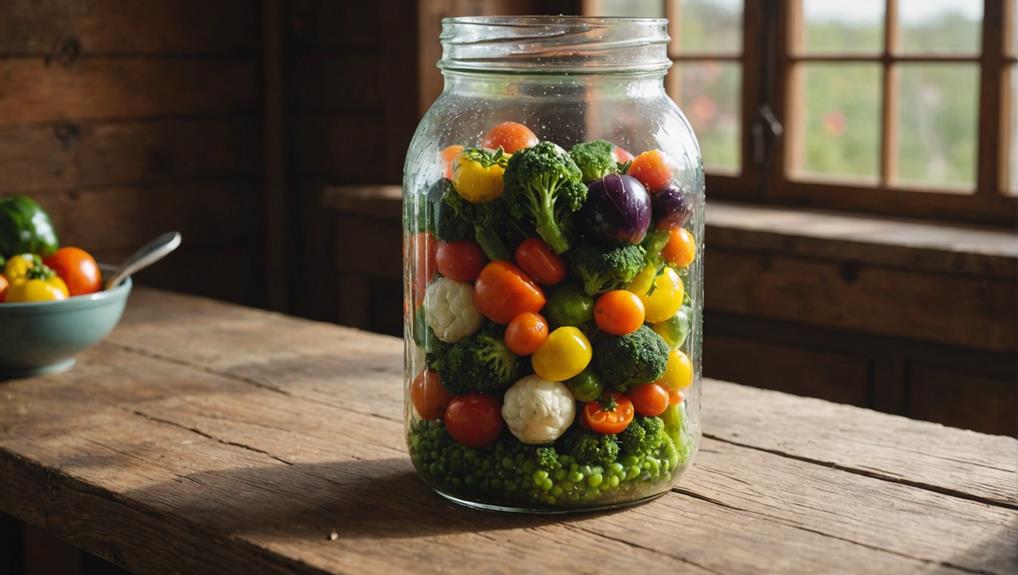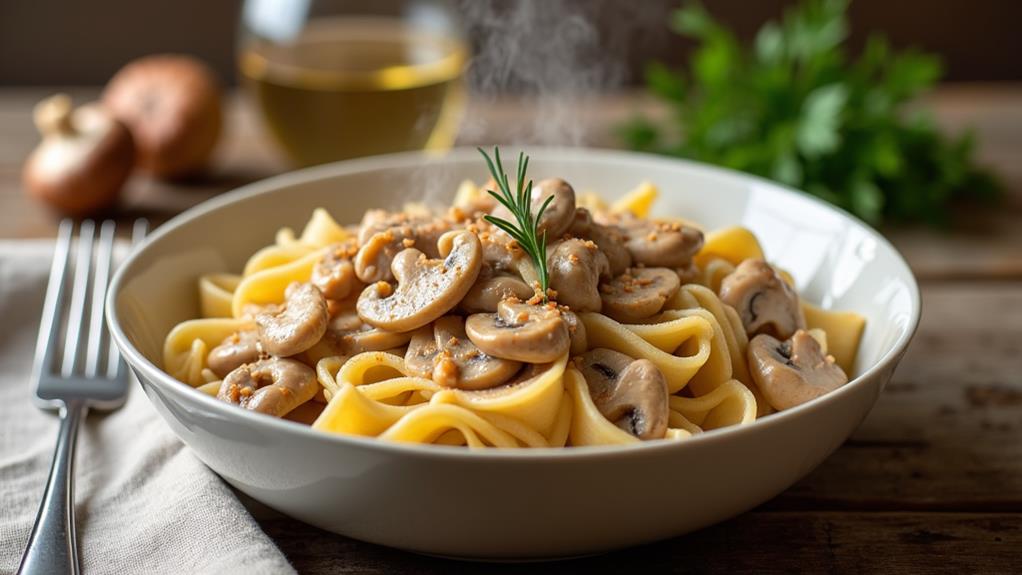Fermentation is nature's alchemy, transforming simple ingredients into complex, flavorful foods through microbial action. You'll discover how anaerobic processes create beloved products like yogurt and beer, while enzymes act as catalysts to break down molecules. Lactic acid bacteria play a crucial role, developing unique flavors and preserving foods naturally. As you explore fermentation, you'll uncover its probiotic benefits, enhancing gut health and potentially boosting your immune system. By mastering this ancient art, you can create your own fermented foods at home, controlling temperature, time, and pH levels for optimal results. The deeper you venture into fermentation's wonders, the more culinary magic you'll unlock.
The Science of Microbial Transformation
Through the lens of microbiology, fermentation reveals itself as a fascinating dance of microscopic life. You're witnessing nature's alchemy at work, as tiny microorganisms transform simple sugars into complex flavors and textures. This process, driven by bacteria and yeast, occurs in the absence of oxygen, creating an environment ripe for innovation.
At the heart of fermentation are lactic acid bacteria, nature's culinary architects. They're not just preserving your food; they're crafting a symphony of flavors while producing beneficial probiotics. These microscopic marvels enhance your gut health and improve digestion, making fermented foods a powerhouse of nutrition.
You'll find that different foods require specific microbial strains. Lactobacillus, for instance, transforms milk into tangy yogurt, while Saccharomyces turns flour and water into pillowy bread. The magic lies in controlling temperature and time, as these factors critically influence flavor development and product safety.
Fermentation can take hours or months, depending on the desired outcome. To ensure consistent quality and safety, you must monitor pH levels and microbial activity throughout the process. This vigilance prevents spoilage and guarantees a delicious, health-promoting end product.
Anaerobic Processes Unveiled
While the microbial dance of fermentation captivates, it's the absence of oxygen that sets the stage for true culinary magic. Anaerobic fermentation transforms ordinary ingredients into extraordinary Food and Wine, elevating your dining experience to new heights.
You'll find this process at work in the creation of yogurt, sauerkraut, beer, and wine, where specific microorganisms thrive in oxygen-free environments.
To harness this power, you'll need to create the perfect conditions. Control temperature and pH levels carefully, as they're crucial for the success of your fermentation project.
Different microorganisms require tailored environments: Lactobacillus for dairy products, and Saccharomyces cerevisiae for alcoholic beverages.
As you embark on your fermentation journey, remember that quality control is paramount. Monitor pH levels and microbial counts to prevent spoilage and ensure safety.
Enzymatic Magic in Fermentation

In the fascinating world of fermentation, enzymes act as nature's catalysts, orchestrating the breakdown of complex molecules into simpler forms.
You'll find these microscopic powerhouses hard at work, transforming starches, proteins, and fats into more digestible and flavorful compounds.
As you explore the enzymatic magic of fermentation, you'll discover how these tiny molecular machines create the unique tastes, textures, and nutritional profiles that make fermented foods so special.
Enzymes: Nature's Catalysts
Unlocking the secrets of fermentation reveals the pivotal role of enzymes, nature's microscopic catalysts. These remarkable proteins accelerate chemical reactions, transforming complex sugars into simpler forms that microorganisms can readily use.
Enzyme specificity allows for precise control over fermentation processes, ensuring that only desired reactions occur. Understanding enzyme kinetics helps you optimize fermentation conditions, maximizing efficiency and product quality.
You'll find that key enzymes like amylase and lactase are crucial in various fermentation applications. Amylase breaks down starches, while lactase tackles lactose in dairy products.
By harnessing the power of these enzymes, you can influence the flavor, aroma, and texture of your fermented creations. However, be aware that enzyme inhibitors can slow down or halt these processes, affecting your results.
To achieve optimal enzyme activity, you must carefully control temperature and pH levels. These factors can significantly impact the speed and outcome of fermentation.
Breaking Down Complex Molecules
Through the enzymatic magic of fermentation, complex molecules undergo a remarkable transformation. You'll witness nature's alchemy as microorganisms produce enzymes that break down intricate structures into simpler, more digestible forms. This process enhances both flavor and nutritional value, making fermented foods a powerhouse of innovation in your diet.
For instance, the comforting qualities of butternut squash soup illustrate how seasonal ingredients can create rich flavors and health benefits.
Consider the following enzymatic marvels:
- Sugar breakdown: Lactase converts lactose into glucose and galactose, making dairy products more accessible for those with lactose intolerance.
- Protein fermentation: Enzymes break down proteins into amino acids, improving digestibility and creating unique flavor profiles.
- Fatty acid conversion: Complex fats are transformed into simpler compounds, enhancing absorption and contributing to the distinct tastes of fermented foods.
You'll find that fermentation's enzymatic action doesn't stop there. It also increases the bioavailability of essential nutrients by breaking down anti-nutrients, allowing your body to absorb vitamins and minerals more effectively.
The production of organic acids, such as lactic acid in sourdough and kimchi, not only preserves foods but also imparts that characteristic tangy flavor you've come to love in fermented delicacies.
Lactic Acid's Crucial Role
You'll find that lactic acid plays a pivotal role in fermentation, contributing to the tangy flavors you love in foods like yogurt and sauerkraut while simultaneously acting as a natural preservative.
This organic acid doesn't just enhance taste and safety; it's also a key player in promoting gut health by supporting the growth of beneficial bacteria.
As you explore fermented foods, you'll discover that lactic acid fermentation can increase nutrient bioavailability, making these foods not only delicious but also more nutritious.
Flavor Development Mechanism
Lactic acid bacteria (LAB) are the unsung heroes of fermentation, transforming ordinary ingredients into flavor powerhouses. These microscopic marvels work tirelessly to convert sugars into lactic acid, creating a sour profile that's both delicious and protective.
As LAB go about their business, they're not just preserving your food; they're crafting a complex symphony of flavors.
The flavor development mechanism in fermentation is a fascinating process:
- LAB produce lactic acid, lowering the pH and creating a tangy taste.
- Carbohydrates break down, forming various flavor compounds like esters and aldehydes.
- The fermentation environment promotes the bioavailability of nutrients, enhancing both flavor and nutrition.
You'll notice a remarkable taste evolution as fermentation progresses. The initial sweetness gives way to a more complex, sour profile that's characteristic of foods like yogurt and sauerkraut.
This transformation isn't just about taste; it's a natural preservation method that keeps harmful bacteria at bay. By harnessing the power of LAB, you're not only creating delicious foods but also tapping into an age-old technique that's both innovative and health-promoting.
Preservation and Safety
Beyond its flavor-enhancing properties, lactic acid plays a vital role in food preservation and safety. When you employ fermentation techniques, you're harnessing the power of lactic acid bacteria to create an environment hostile to foodborne pathogens.
These beneficial microbes produce lactic acid, which lowers the pH of your fermented foods to around 3.5 to 4.5, effectively inhibiting the growth of harmful bacteria like E. coli and Salmonella.
This natural preservation method doesn't just extend shelf life; it revolutionizes food safety. As you ferment foods like yogurt or sauerkraut, you're creating a barrier against spoilage organisms, ensuring your creations remain safe and delicious for longer periods.
The acidic environment generated by lactic acid acts as a natural preservative, reducing the need for artificial additives.
Moreover, the metabolites produced during fermentation contribute to the unique tangy flavor profile you've come to associate with fermented foods.
This dual action of preservation and taste enhancement showcases the innovative potential of fermentation. By understanding and applying these principles, you're not just preserving food; you're participating in a time-honored tradition of culinary alchemy that continues to evolve and inspire.
Gut Health Benefits
The gut health benefits of lactic acid extend far beyond its role in preservation. This powerful compound, produced during fermentation, creates an acidic environment in your gut that inhibits harmful bacteria growth.
By consuming fermented foods rich in lactic acid bacteria, you're not just enjoying unique flavors; you're actively promoting digestive harmony and boosting your microbiome diversity.
Lactic acid's impact on your gut health is multifaceted:
- It improves digestion and reduces gastrointestinal discomfort.
- It enhances the absorption of essential minerals like calcium and magnesium.
- It positively influences the gut-brain axis, potentially improving mood and reducing anxiety.
These benefits contribute to a healthier, more balanced gut ecosystem.
By fostering an environment conducive to beneficial bacteria growth, lactic acid helps maintain a diverse microbiome, which is crucial for overall health and disease prevention.
Moreover, the improved nutrient absorption can lead to better overall nutrition, supporting various bodily functions.
Incorporating fermented foods into your diet is a simple yet effective way to harness these gut health benefits, promoting digestive wellness and potentially reducing the risk of chronic diseases.
Probiotic Powerhouses

While many people associate fermentation with tasty foods and drinks, it's also a powerful way to boost your health through probiotics. These microscopic marvels, found in abundance in fermented foods like yogurt and kimchi, are revolutionizing our approach to digestive wellness. By improving the balance of gut flora, probiotic varieties help enhance your overall digestive system function.
You'll be amazed at how these fermentation methods can transform your health. If you're lactose intolerant, consuming probiotic-rich foods may reduce your symptoms by increasing lactase production. The benefits don't stop there; fermented foods like sauerkraut pack a punch with up to 100 million CFUs per gram, significantly bolstering your immune function.
But it's not just about physical health. The gut-brain axis, influenced by probiotics, can improve your mood and mental well-being by promoting serotonin production.
Moreover, regular consumption of these probiotic powerhouses may lower your risk of chronic diseases such as obesity and diabetes. By enhancing metabolic health and reducing inflammation, you're investing in a healthier future. Embrace these fermentation wonders and unlock their potential for your well-being.
Mastering the Art of Fermentation
Now that you've discovered the health benefits of fermented foods, you might be eager to create your own probiotic-rich delicacies at home. Mastering the art of fermentation requires understanding various fermentation techniques, cultural variations, and ingredient selection.
To begin your journey, focus on these key aspects:
- Microorganism knowledge: Familiarize yourself with specific bacteria and yeasts for different ferments, like lactic acid bacteria for yogurt or wild yeast for sourdough.
- Environmental control: Monitor temperature and duration carefully, as each ferment has unique requirements for optimal flavor development.
- Safety measures: Implement quality control practices, such as pH testing and visual inspections, to ensure food safety and prevent spoilage.
Different fermentation methods, from anaerobic sauerkraut to aerobic kombucha, demand varying conditions to enhance flavor and texture.
As you experiment with diverse cultural variations, you'll discover how ingredient selection impacts the final product. To accelerate your learning, engage with community resources like workshops and online forums.
These platforms offer invaluable insights and troubleshooting advice from experienced fermenters. With practice and patience, you'll soon be crafting delicious, probiotic-rich foods that rival store-bought varieties.
Frequently Asked Questions
Can Fermentation Occur in Extreme Environments Like Hot Springs or Deep-Sea Vents?
Yes, fermentation thrives in extreme conditions like hot springs and deep-sea vents. You'll find incredible microbial diversity adapting to these harsh environments, using unique energy sources to power their metabolic processes. It's nature's innovative survival strategy in action.
How Does Fermentation Impact the Shelf Life of Different Food Products?
Ever wondered about food's longevity secret? You'll find fermentation's the key. It extends shelf life by creating a microbial balance, enhancing flavors, and boosting nutritional benefits. This innovative process revolutionizes how you preserve and enjoy various foods.
Are There Any Risks Associated With Consuming Too Many Fermented Foods?
While fermented foods boost gut health, overconsumption can disrupt your digestive balance. You might experience bloating or aggravate food allergies. It's best to introduce them gradually, innovating your diet with moderation for optimal benefits.
Can Fermentation Be Used to Create Non-Food Products or Materials?
Where there's a will, there's a way! You can harness fermentation's power beyond food. It's revolutionizing industries, creating biodegradable materials, enhancing textile production, and driving biofuel generation. Embrace this innovative process to shape a sustainable future.
What Role Does Fermentation Play in Traditional Medicine and Holistic Healing Practices?
You'll find fermentation's ancient practices deeply rooted in traditional medicine. It's revolutionizing holistic healing with probiotic benefits that boost gut health. You're tapping into nature's pharmacy, unlocking innovative solutions for your well-being through fermented remedies.
Final Thoughts
You've now unlocked the secrets of fermentation, a process that's both ancient and cutting-edge. While some may view fermented foods as strange or off-putting, you'll find that they're not only delicious but also incredibly beneficial for your health. By harnessing the power of microbes, you can create probiotic-rich foods at home, boosting your gut health and exploring new culinary frontiers. Embrace this natural alchemy, and you'll discover a world of flavors and benefits that'll transform your diet and well-being.















